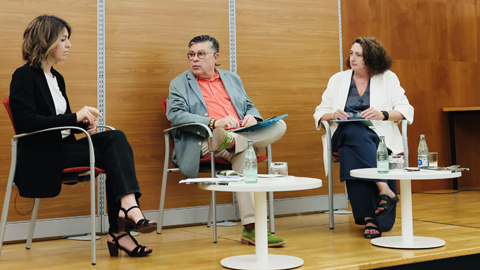What will our society look like in 50 years?
What challenges is demographics facing in Catalonia, Spain and in other parts of the world? What will our society look like 50 years from now? How to solve ageing population and a low birth rate? What role does migration play? These are some of the questions answered in the new issue of the journal IDEES, edited by the Centre for Contemporary Studies. This issue has been coordinated by the UAB Centre for Demographic Studies and is dedicated to demography. Presented on Wednesday 17 September, the new issue x-rays the present and future of our demography, with expert data and analyses.

A 117-page report, with articles by a dozen of experts, most of them from the UAB's CED, discuss key issues of the future of societies in Catalonia, Spain and the world.
The Centre for Demographic Studies (CED) at the UAB has coordinated the latest issue of the IDEES journal, published by the Centre for Contemporary Studies of the Government of Catalonia and presented on Wednesday 17 September at the Casa Convalescència UAB in Barcelona.
Its 117 pages address key issues for the future of society, divided into three main thematic blocks: demographic challenges in Catalonia with its eight million inhabitants, fertility and family transformations in Spain, and the international outlook on migration, ageing, and fertility.
The dozen lecturers and researchers who sign the content raise issues such as possible tensions in social security due to population trends, immigration and its impact on school results in Catalonia as an indicator of the integration process, the future of society with an ageing population, and the relationship between declining fertility and the socioeconomic factors that help explain its evolution.
This new issue of the journal was presented at an event featuring speeches by Andreu Domingo, coordinator of the publication, deputy director of the UAB's CED and principal investigator of the Globalization, Migration, and Space research group, and demographer Dolores Puga, researcher at the Research Group on Aging of the Spanish National Research Council (CSIC).
In addition to Andreu Domingo and Dolores Puga, the volume contains articles by the director of the CED and lecturer at the UAB, Albert Esteve, as well as other UAB lecturers and CED researchers such as Julián López Colás, Pau Miret, Jordi Bayona Carrasco, Diederick Boertien, and Iñaki Permanyer. Alongside these are writings by researchers and professors from other centres, such as Massimo Livi Bacci, Roberta Rutigliano, Leo van Wissen, and Alicia Adserà.
Demographic challenges for Catalonia
The initial article on demographic challenges (written by Julián López Colás and Albert Esteve) explains that the three major demographic challenges facing Catalonia in the coming years are population size and distribution, population ageing, and social cohesion in the face of growing diversity.
According to Idescat, Catalonia is expected to continue growing in the medium and long term. The average scenario estimates that Catalonia's population will reach 8.4 million in 2041 and 8.7 million in 2071, driven mainly by positive net migration from abroad. Territorially, a greater concentration of population is expected in cities with more than 50,000 inhabitants and in the coastal and pre-coastal regions.
In terms of ageing, it is estimated that by 2071, the population over 65 will represent 29.4% of the total, compared to 19.0% in 2023. The old-age dependency ratio (which relates the number of people over 65 to the number of people between 15 and 64) will rise from 29.1% in 2023 to 43.7% in 2041 and 50.4% in 2071. This will put increasing pressure on the labour system and social services, with significant regional disparities between urban and rural areas, and between coastal and inland regions.
Catalonia has maintained one of the highest life expectancies at birth in Europe: in 2023, it will reach 81.3 years for men and 86.5 years for women. The birth rate, meanwhile, has continued to fall: the total fertility rate has decreased from 1.28 children per woman in 2001 to 1.1 children in 2023, which has accentuated the generational imbalance.
The third major challenge is the growing diversity of the Catalan population. Of the 8 million people currently living in Catalonia, only five million were born here. The article highlights that the foreign population is mainly concentrated in large cities and points out that “Catalonia needs the arrival of foreign workers of working age because they bring vitality to the population and the economy, as well as cultural diversity, but their integration requires policies that promote a cohesive society and minimise inequalities.”
Online version of the IDEES journal: Demography: the challenges facing the society of the future
The UAB, with Sustainable Development Goals
Good health and well-being
Reduced inequalities
Peace, justice and strong institutions